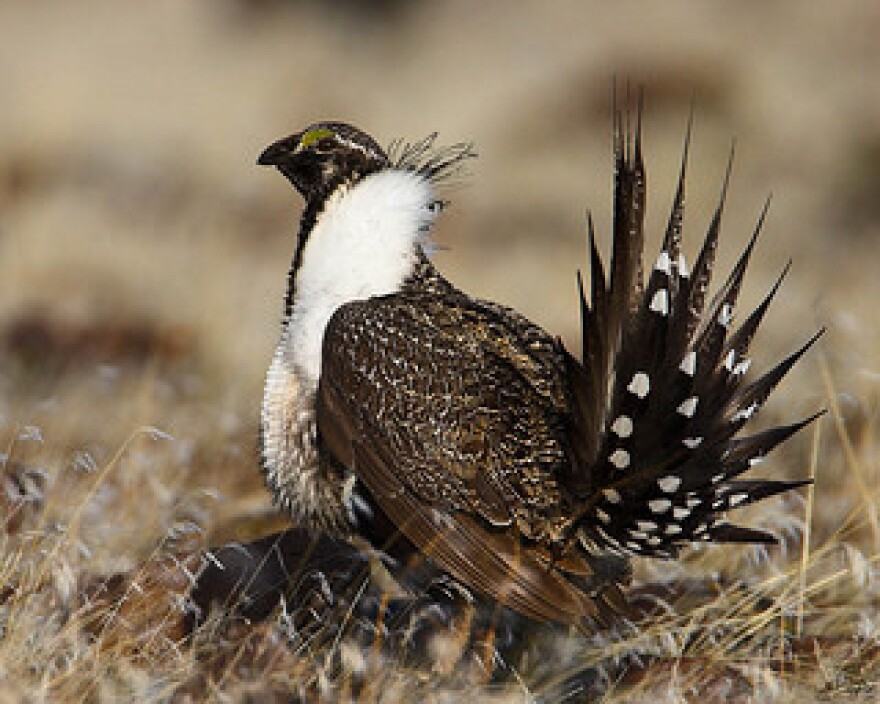The West’s greater sage grouse are in trouble. The birds make their homes in desert sagebrush country. But their habitat is shrinking – because of people, wildfires, and agriculture. With fewer wide-open places to live, sage grouse numbers are dwindling. For EarthFix, Courtney Flatt takes a look at one program that’s relocated sage grouse from Oregon to Washington.
It’s early in the morning, hours before sunrise.
An old pickup truck turns down a dirt road at Swanson Lakes Wildlife Area in Eastern Washington. About a 90 minute drive west from Spokane.
Anderson: “Boy, it’s pretty foggy out.”
Juli Anderson manages the wildlife area. She’s squished into the truck’s middle seat. In the back seat are five cardboard boxes.
Each holds a sage grouse. The turkey-sized birds were captured in southeastern Oregon. They’ve been fitted with monitoring devices and are ready to be released here – to help boost this sage grouse population.
A radio that tracks already released sage grouse hums in the background. It faintly beeps when it catches a signal nearby.
This area was historically home to the birds – sometimes called a fool hen for their quirky behavior during mating season.
The last big sage grouse mating ground was about 10 miles from where we’re driving.
Anderson: “They had been pretty much shot out in the ‘80s. There had been occasional sightings of sage grouse up until the early ‘90s, and then they petered out.”
Greater sage grouse numbers are declining across the Western United States. A lot of the problem: there just isn’t as much habitat as there once was. Much of it is now fragmented.
Tim Griffiths is the national Sage Grouse Initiative coordinator. The conservation group is working to save sage grouse in 11 Western states. Griffiths says every state has different problems with its habitat.
Griffiths: “In Oregon, Nevada, Idaho, you have a lot of encroaching conifer trees, where we’ve kept fire out for 100 years. Those trees march out on the arid, desert environment and fragment the landscape that way. Or somewhere like up in Washington, where we’ve had wholesale conversion of historic native range for wholesale crop production.”
Griffiths says sage grouse habitat has been cut in half. He says what’s left isn’t always ideal habitat. That caused sage grouse numbers to drop by 90 percent.
The Sage Grouse Initiative is coordinating various agencies, ranchers, and landowners to work together and protect some of that historic habitat.
Four years ago, the U.S. Fish and Wildlife Service decided that greater sage grouse numbers were in enough trouble they should be on the Endangered Species List. But other species were in deeper trouble, so the greater sage grouse got wait-listed. The service will reexamine that decision next year.
Biologists in the Northwest are working to boost numbers locally – like this experimental relocation project at Swanson Lakes.
At the end of the dirt road, we pull up to the mating ground. Anderson whispers so that she doesn’t disturb the birds.
Anderson: “So we have arrived in this open field. Our settling boxes are off to the left. Just back in the sage brush a little bit.”
Anderson, with her colleague Mike Finch, will introduce the five sage grouse to their new home in what they call a “soft release.”
That means they put the birds in small, black wooden boxes. This helps them calm down before they enter the mating ground.
The wind picks up as they take the birds inside the cardboard boxes from the back seat of the pickup. They walk through sagebrush brambles to the soft release boxes.
Anderson: “Do we wanna start with the hens here?”
Today Anderson and Finch are releasing four females and one male sage grouse.
They open the boxes one at a time.
Check to make sure the birds are okay.
Anderson: “Okay, she looks good.”
And put the birds in the soft release boxes.
Each Western state has come up with its own greater sage grouse restoration plan. Tim Griffiths hopes the many efforts -- like this one at Swanson Lakes -- are enough to keep the bird off the endangered species list next year.
Griffiths: “This is really the largest Endangered Species Act experiment ever conducted. Nobody knows the ultimate outcome, but all indicators are we’re moving the needle significantly for sage grouse.”
Anderson says that’s the case at Swanson Lakes.
The Washington Department of Fish and Wildlife has been relocating birds here since 2008. Anderson says there are now about 60 birds at this mating ground that was once wiped out.
At the edge of the Eastern Washington mating ground, known as a lek, we take cover behind sagebrush that’s about five feet tall.
Anderson and Finch plan to pull a long thread of fishing line to open the soft release box doors.
But before they can release the grouse, the door falls off its hinge. Three of the females fly out.
Anderson: “They didn’t flush wild. A couple hens flushed off to one side – but toward the lek area. They’re okay.”
They release the rest of the birds and head back toward the pickup truck.
Anderson says 20 years ago, she didn’t think she’d see sage grouse forming a mating ground here.
Anderson: “To see them back here, it just seems like the way it ought to be. They belong on the landscape.”
They hope to capture and release 20 males and 20 females at the mating ground this spring.
After that, everyone will wait to see if the greater sage grouse will make the endangered species list next year.


